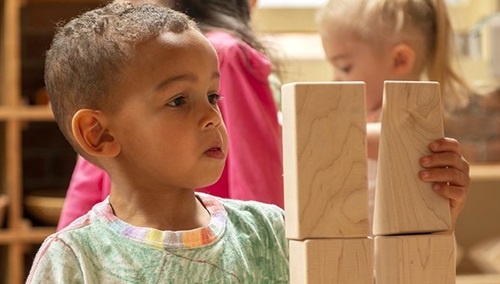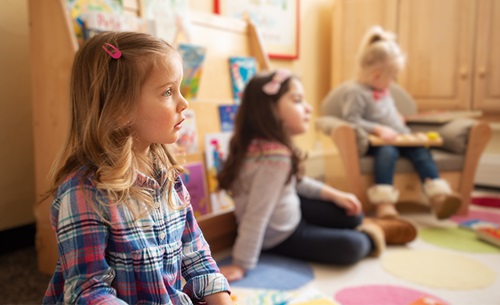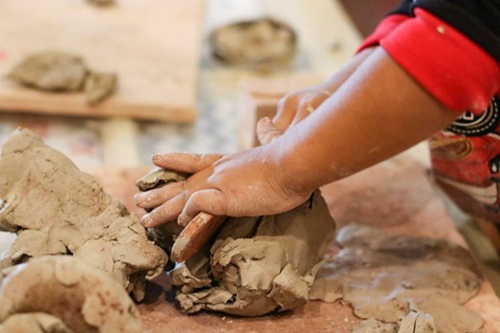It Might Get Messy!
| May 2022I was 19 years old when I landed my first job as a preschool teacher. The school had about 10 classrooms and served infants through school age children. It was a part of a large corporate chain of childcare centers. I remember meeting the director during the interview for the job. I don’t remember most of the interview, but I do remember the woman asking me if I would be the kind of teacher who would let the kids “get messy” and finger paint with chocolate pudding. Chocolate pudding! I thought that sounded like so much fun. I was going to love it here. At the time I had no college coursework related to child development and no work experience with groups of children. I had done my share of babysitting, but I was hugely under-qualified for this job; it didn’t matter, I was excited to be a preschool teacher.
Quickly, I found out that being a preschool teacher at this center meant lots of moving from room to room, working with different groups of children. I was expected to keep the kids safe, entertained, and especially under control. The rooms needed to be kept cute and clean. I was regularly left alone with groups of 15-20 children at a time, with few supplies. It was stressful, chaotic, and a bit confusing. This was not the kind of “messy” I signed up for. I can’t say I remember what I did with kids; but we definitely were not finger-painting with chocolate pudding!
A few years later, I was fortunate to move to a totally different childcare environment. My next job was at a school that was more resourced, supportive and, yes, messy in the right ways. I had some early childhood development college coursework by then, and some more life experience under my belt. Still, I had a misconception of my role as “teacher.” My practice had improved and my skillset was greater, but my understanding of “who” was in control of the learning was off. I was the “teacher” so I must “teach.” This construct changed when I was introduced to the amazing work of the late Bev Bos. To say that my eyes were opened to a new approach is an understatement. Her work resonated deeply, at a soul level; children should lead and direct their own learning through PLAY. Unpredictable, fun, often loud, joy-filled and yes, messy play. I did not need to control children, or even “teach” them, I needed to support their learning by offering an environment rich with open-ended materials, space to explore and lots of time to play.
Anyone working with young children knows that it’s messy work. Children with developing bodies and developing minds explore their environment in ways we adults don’t always understand. We want to provide spaces that are safe, fun, clean, and even inspiring. However, play doesn’t always unfold neatly in our classroom spaces.
There are countless benefits to a childhood rich with real play, yet time for play is declining more and more. We are now at a critical point in time where we are seeing the impact of what happens when children are not given enough time for free, unstructured play. Well-meaning adults are opting for an academic approach rather than a play-based one, and the outlook is dismal.
According to the Centers for Disease Control, diagnoses of ADHD, childhood obesity, depression, and anxiety are all on the rise. Children are over-scheduled, faced with unrealistic academic standards, and spend more and more time in front of screens. Children’s scores on creativity tests are declining too. Researcher Kyung Hee Kim published a study that revealed a continuous decline in creativity in American school children over the last three decades that is linked to an increase in narrow academic goals and insufficient free play and unstructured time.
In 2019, the American Academy of Pediatrics updated and strengthened their position statement on the necessity and benefits of play. It is clear, play has many benefits. Play fosters healthy bodies, healthy relationships, and healthy brains. In fact, play is an ideal state of mind for creativity and learning. The brain changes physiologically as a result of experience. As a child experiences something new, the brain looks to associate this experience with old information creating the foundation for what we call “learning.” Research done by Sergio Pellis (University of Lethbridge Canada) found that during play, connections are formed at the front end of the brain. It is here (the pre-frontal cortex) where critical thinking, self-regulation, empathy, problem solving, higher order thinking skills and CREATIVITY take place. Pellis suggests that without play, those connections are not formed.
Some hallmarks of real play, defined by researcher Peter Gray, are that play is self-chosen, self-directed, and involves an active, alert, non-stressed frame of mind. The mind is focused on means not ends (process not product) so fear of failure is absent. Players, using all of their senses, are free to incorporate new sources of information and experiment with new ways of doing things; exactly the definition of creativity.
So how do we do this? We pay close attention to our learning environments. We provide spaces that are safe both physically (free from hazards, appealing to all of the senses, organized, and aesthetically pleasing) and emotionally (relationship is the number one priority and adults understand their role). The adults trust the children, the children trust the adults, and the adults trust each other. Then, and only then, can we begin the work of enriching our environment with fun, messy, creative, open-ended materials and activities. And since it might get messy, have a plan to deal with those messes.
Think “set up, process, clean up”. Have a plan for what will happen before, during, and after the children engage with a messy activity. Practically, this might look like gathering supplies before the children arrive, covering tables with butcher paper or tarps, having some damp towels on hand or providing shallow bins of soapy water and scrub brushes for cleaning up. Children will get messy, wet and even dirty; have a plan for this too. Prepare families in advance of their children coming into the program. Let them know that a natural byproduct of learning and creativity will be that children will get messy. Be sure to have extra clothing on hand, as well as towels and wipes for cleaning up.
There will be resistance and there will be roadblocks to providing this kind of environment. Have the hard conversations. Discuss the benefits and challenges with your team and with the families you serve (yes, this can get messy too). Early educators must have the conviction to implement. We need to get better at identifying and communicating the valuable learning and development that occur when children direct their own learning through open-ended, creative (often messy) play. Adults may not need to be in control of the learning, however we do need to be in control of what is happening to play.
Creativity is messy work. Literally and figuratively. We adults have natural preferences and biases about creative behaviors. The locus of control shifting can be uncomfortable for the adult. Children will naturally exhibit curiosity, independence, and seek novelty. Their experiments will be messy in so many ways. There will be physical messes, social messes, emotional messes, and cognitive messes. Your schedule will get messed up, your lesson plans will get messed up and perhaps, like me, your notion of what it is to be a “teacher” will get messed up too. However, we cannot afford to let our adult needs for order and control get in the way of the children’s need for creative, messy, meaningful, fun play. Will you embrace the mess and join me in advocating for play?
Photos courtesy of the author.










